
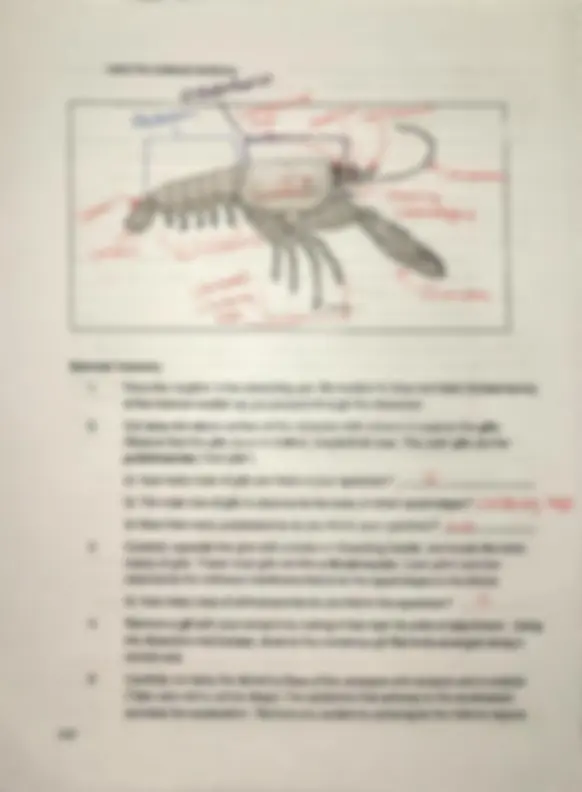
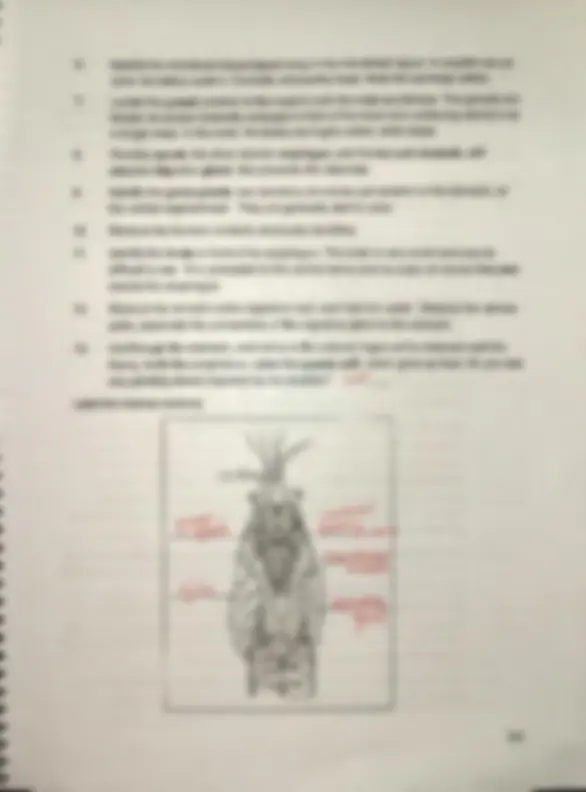
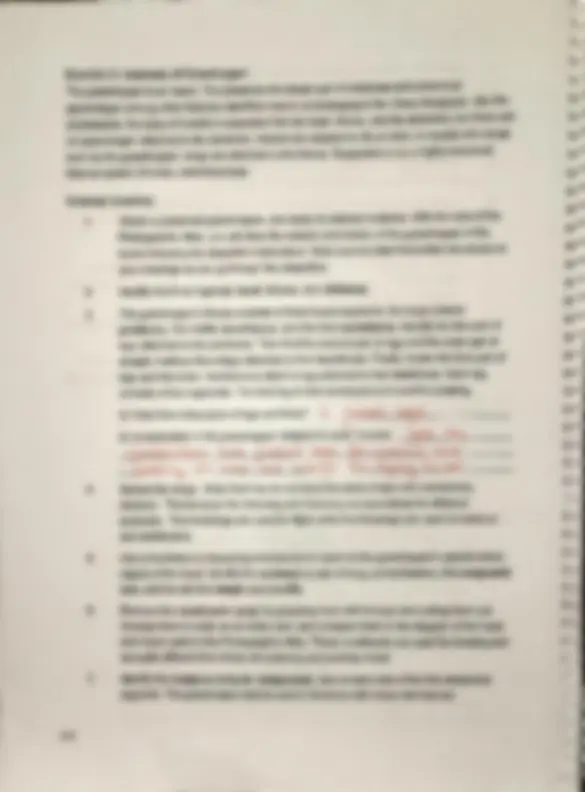
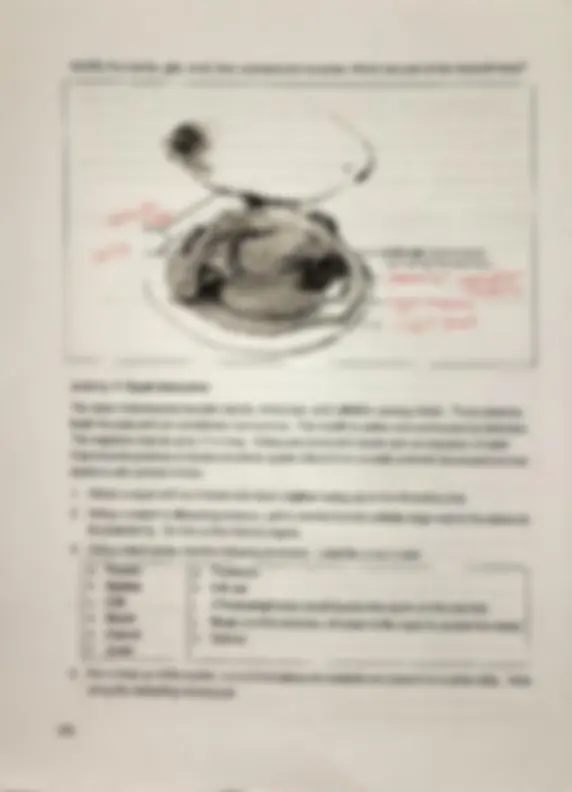
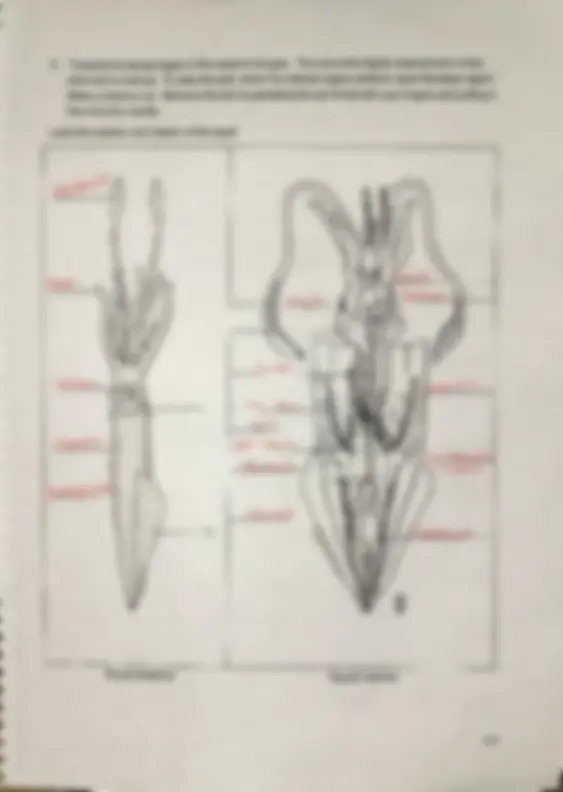
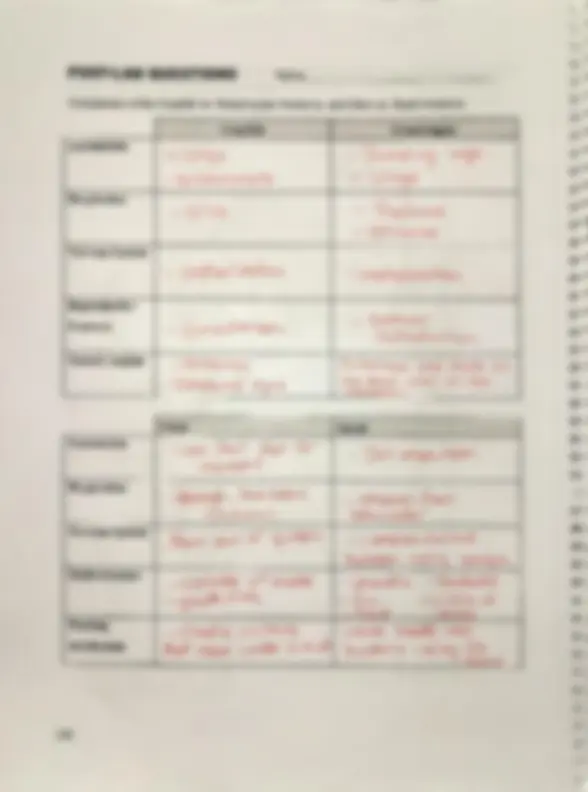


Study with the several resources on Docsity

Earn points by helping other students or get them with a premium plan


Prepare for your exams
Study with the several resources on Docsity

Earn points to download
Earn points by helping other students or get them with a premium plan
Community
Ask the community for help and clear up your study doubts
Discover the best universities in your country according to Docsity users
Free resources
Download our free guides on studying techniques, anxiety management strategies, and thesis advice from Docsity tutors
Biology/Chemistry Laboratory homework for Lab 12
Typology: Lab Reports
1 / 10

This page cannot be seen from the preview
Don't miss anything!







synapomorphies include a complete digestivesystem (runs from mouth^ to^ anus),a double ventral nerve chord, andexcretory organs called theMaphighian tubes.
Sexesareseparate:^ arthropods^ copulateandhaveinternal^ fertilization.^ Most^ arthropods^ care^ for^ the eggsinsomeway,eitherbylaying eggs withprotective shellsinoronafoodsource or by carrying them aroundontheir^ bodiesuntil^ the^ eggs^ hatch.^ Females^ carrying^ eggsarecalled^ gravid^ females. Larvae are oftenvery differentfrom adultsandundergo metamorphosisina short period oftime.
Inthis laboratory,you willbeworkingingroups^ oftwoonthedissection of^ the^ organism assigned^ to youbytheprofessor.You willberesponsible for identifying the externalandinternal features of your
Don't forgettocheck out the other specimens that are available attherear of^ the^ lab.)
Asa member of^ the^ Class^ Crustacea,^ the^ crayfish^ shares synapomorphies with other crustaceans. This includes^ jointed,^ paired^ ,andbiramous^ appendages,^ two^ pairs^ of antennae,andthree body regions (the head, thorax, and abdomen). Crayfishareknownto bescavengers, but they^ also^ prey ion other invertebrates. The mouthissurrounded by appendages modified for feeding,andthere is a well-developed digestive tract. Dorsal, anterior,andposterior arteries carry hemolymph (blood plus lymph) to tissue spaces (hemocoel)andsinuses.Incontrasttovertebrates, there is a ventral solid nerve cord. Crayfish are adapted toanaquatic existence.
all the way down^ to^ the^ tail. Q: Iseach region specialized for its function? -~-+re..:~5 ___________ _
Q: Which body region of the crayfish^ is^ most obviously segmented? BrvleN\e ~
raisednipple containinganopeningforthe^ green glands,^ theorgans^ of^ excretion. Crayfish excretealiquid^ nitrogenouswaste. Q:Thenitrogenous waste would result fromthebreakdownof^ which^ group^ of macromolecules? pro.t-...:.n:S ~ /'\LAc.l£c..i,^ <:U:c.l
Q: How would you differentiate walking legs from swimmerets? WO-\.~~ ~~ 0-("J!^ a~4-5-es^ ~^ dt-d;^ :tc
(^68) Mac0rganisms2: Crayfish Anatomy; https://www .youtube.com/watch?v=2cBGuEDxvNo
I I I J I - , ,
open circulatory system. Carefully remove the heart. Note the openings (ostia).
tubular structures bilaterally arranged in front^ of^ the heart and continuing behind it as a single mass.Inthe male, the testes are highly coiled, white tubes.
attached digestive gland, that precedes the intestine.
the ventral segment wall. They are generally darkincolor.
difficult to see. It is connected to the ventral nerve cord by a pair of nerves that pass around the esophagus.
parts, especially the connections of the digestive gland to the stomach.
heavy, tooth-like projections, called the gastric mill, which grind up food. Do you see any grinding stones ingested by the crayfish?^ -~^ ,t;.5"' Label the internal anatomy .. lof,N.Wlloilr,U.C
Exercise2:AnatomyofGrasshopper Thegrasshopperis^ aninsect.^ Thepresenceof a^ single^ pair^ of^ antennaeanduniramous appendagesamongother^ features^ identifies^ insectsasbelonging^ to^ theClass^ Hexapoda.^ Like^ the crustaceans,thebody ofinsectsisseparated^ into^ thehead,thorax,and^ theabdomen,^ but^ thereare noappendages^ attachedto^ theabdomen.^ Insectsareadaptedtolifeon^ land.Ininsects^ with^ wings, suchasthegrasshopper,^ wingsareattachedto^ the^ thorax.Respirationis^ bya highly branched internal systemoftubes,calledtracheae^.
External Anatomy
Obtainapreservedgrasshopper,andstudyitsexternal^ anatomy.^ With^ thehelp of^ the Photographic^ Atlas,youwill^ drawtheexteriorandinterior ofthegrasshopperinthe boxesfollowingthedissection^ instructions^ .Makesuretolabelthebolded^ structureson your drawingsasyou go thoughthedissection.
Thegrasshopper 's thorax^ consistsofthree^ fused^ segments:^ the^ large^ anterior
legs attachedto theprothorax^ .Then^ find^ thesecond^ pair^ oflegs^ andthe^ outer^ pair^ of
consistsoffivesegments.^ The^ hind^ legiswell^ developed^ and^ usedfor jumping. Q: How How many^ pairsoflegs^ arethere?^ C.^ ~(}~ed.^ le5s Q: Is locomotion in thegrasshopper^ adaptedtoland?^ Explain.^ L('{~^ ,^ -Hi-e. Vl~S$
1 ~£ ~~ Sc1oord.:^ ~^ fu:^ 1JJo.llL~~~^ ~
Spread the wings.^ Notethat^ theydo^ not^ have^ the^ same^ shapeandconsistency (texture) .This^ because^ the^ forewing^ and^ hindwing^ arespecialized^ for different purposes. Thehindwingsare^ used^ for^ flight^ while^ the^ forewings^ are^ usedfor^ balance and stabilization. Useahand lensor dissecting^ microscopetoexamine^ thegrasshopper's^ special^ sense
Arrange theminorderon^ an^ index^ card,^ and^ compare^ them^ to^ the^ diagram^ of^ the^ head and mouth^ partsinthe^ Photographic^ Atlas.^ These^ mouthparts^ are^ used^ for^ chewing^ and are quite different^ from^ those^ of^ a^ piercing^ and^ sucking^ insect.
segment.^ The^ grasshopper^ detects^ sound^ vibrations^ with^ these^ membranes.
.v
~~ ~ ~ ~ ~ ~ ~ ~
t>¢ ~ v ¢
Dorsal Hemocoel artery Crop (^0) varyStomach Heart
Vagina Seminal receptacle Ventral (^) Intestine Oviduct (spermatheca) nerve Ganglia Gastric Malpighian cord (^) caeca tubules (^) c ttay.ic,~MeN.;1. LL c
Identify the mantle, gills, shell, (^) foot, andadductor muscles. Which are part of the visceral mass?
.)
..; I
Activity 3: Squid Dissection
Labialpalp (secre-tes mti1rns tvit1t e11trt1ps food particles)
Ynu- s c..l --c.
c~-~v-v+ st--eJ-l
The class Cephalopoda includes squids, octopuses, andcuttlefish, among others. These possess beak-like jawsand cansometimes inject poison. The mouthiscentral and surroundedbytentacles. The organism may (^) be up to 17 m long. Octopuses creep andsquids dart via expulsion of water. Cephalopods possess a closed circulatory system (blood is invessels) and well-developed nervous systems with complex brains.
POST-LAB QUESTIONS Name: _____ ______
Comparison of the Crayfish vs. Grasshopper Anatomy, and Clam vs. Squid Anatomy
Crayfish Grasshopper
-- u:.~^ _.^ cJ^ LA~;^ l'^5 l~~s ·· ~ ~ MrY\ ~1'"" ~ tS (^) - W,~s Respiration
Reproductive Features _ &o'(_(J) c ha,,-SVY..^ -^ 5~u.o--
r-c p,ei d uc.-h-e _("_ Sensory organs (^) - A--At-0'~ A Vl.--~nna.c CM Pcl<'S Ov"
-~pou.ncl ~tJCS^ ~ o.bdoM.~^ ~~^ I.^ lt:f'c,i^ C)y.^ .-he
-·' ·. Clam. -- -- Squid · Locomotion -u~~ ~'r FceA-- W 'J'f{Jll~
~ ~~+- ~~~J~<?A
Respiration -+hr~'- h,J{} -1-u,bt s -~~~F~ ( s; """~ ')^ 4$~c,.}ef Nervous System (^) , \¼-t---l-- ~ < cf' Cc o.-J'tf,v.. - ( 'QNV.Pl~ v'\efveM.S
~'Q'Z> ~ l-- 43 ' ~ ~o...~~~ Shell structure (^) - C!_ c/l'b ,-Sl> o F ~1 ll.. - ~HI.(_, -+Q',uks
-~'t~ -c=;" -^ C...;^ f'C l<-^ _a( k.l (^) <?<~
mechanism ~ MO.I~ wa:kK ,~ -b J S u c.Aivo, $ u.~~~ ·~ts ~~
v ?Y FY v ~ ~ ~ ~ ~ ~ ~ ~ ~ ~ ~
~ ~ ~ ~ ~ ~ ~
Cffi PJ c::n c:l: ~ 0: ~ c;:I:: c;::c ~ :c::t ~ ,•~ ~ ~ e